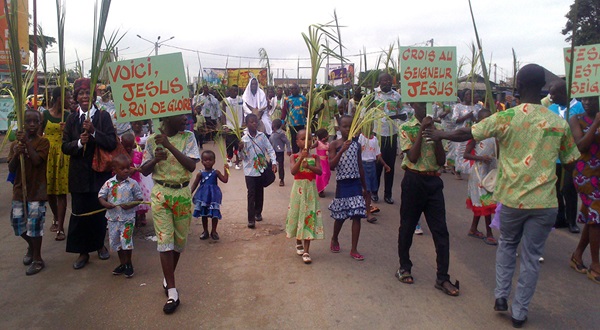Many United Methodists have some memory of the Sunday leading into Holy Week as being primarily about the triumphal entry of Jesus into Jerusalem.
The service might begin outdoors, weather permitting, with everyone given palms to wave as children lead a procession into the sanctuary. It may also feature a choir cantata based on themes from Holy Week. While a day of considerable joy, it might also be a day when the sermon may ask or lament how those who seemed to laud Jesus on Sunday could by Friday morning call for his execution.This was Palm Sunday.
However, since the adoption of The United Methodist Book of Worship in 1992, this final Sunday in Lent has been known as Passion/Palm Sunday. Actions recalling the Sunday Jesus entered Jerusalem are limited to an opening procession, while the main part of the service focuses on reading the lengthy story of the final passion (suffering) of Jesus in his betrayal, arrest, trial and execution. Often, the reading is the sermon. A shift from triumph and elation to horror and sorrow happens abruptly within this single service, setting a somber, solemn tone that continues through the rest of the week.
Why was this change made?
The first western Christian church to make this change was the Catholic Church. It did so as part of the many reforms in worship that came out of the Second Vatican Council in the early 1960s. Vatican II approved this change and many others in response to the findings of decades of ecumenical scholarship in the history of Christian worship and the development of the Christian Year.
That scholarship clarified that the early church created Lent primarily to be a time for intensive preparation of candidates for baptism culminating in an even more intensive time of preparation during Holy Week. Scripture readings for each Sunday in Lent had been selected to support the work of those preparing for baptism with their sponsors during the coming week. The church-wide intensification of practices of prayer, fasting, and ministry with those in need during these 40 days was intended to be a palpable, supportive example for those completing their preparation for baptism.
The situation of much of Christianity changed when Emperor Theodosius declared Christianity the legal religion of the Roman Empire (380 AD). What had been a minority religion within the Empire became the religion of nearly everyone in its reach within just a few decades. So by the late sixth century, few people were being baptized as converts to the faith. They, and probably their parents and grandparents, were baptized as infants. There was little need any longer for Lent to function as a season to prepare converts for baptism because there were few if any converts to prepare.
In response to that reality, the Lenten practices of fasting, prayer, and ministry with the poor had evolved into practices of general penitence among the baptized to help strengthen the spiritual lives of lifelong Christians. The strong connection of the Sunday readings with the purpose of preparing candidates for baptism became less focused as well.
The Protestant Reformations of the 16th century added more variety to the observances of Lent. Some traditions observed a day called “Passion Sunday” on the fifth Sunday of Lent, but with readings that focused on Jesus’ call to take up the cross and follow him, not his own passion (suffering). Palm Sunday observances might occur on either the Fifth or the Sixth Sunday of Lent. And both Catholic and some Protestant traditions either read or heard choral performances of Matthew’s version of the passion story of Jesus on the Sixth Sunday of Lent.
The ecumenical scholarship combined with the growing awareness that conversion to the faith had again become more prevalent led those meeting at Vatican II to call for a realignment of the Christian calendar and its observances to meet the challenges of this new normal. This included a modern recovery of the early church’s worship and formation practices during Lent for those preparing for baptism as converts. Readings for the first five weeks of Lent would focus on living in the way of Jesus. For the sixth Sunday, the beginning of the week of the most intense preparation, they combined a Palm Sunday processional with the reading of the passion of Jesus from one of the synoptic gospels (Matthew, Mark, or Luke). That flow created a greater emphasis on the gospel reading and a more dramatic segue for the entire church into the final and most intense week of preparation, Holy Week.
In other words, the Catholic Church changed Palm Sunday to Passion/Palm Sunday in order to make their worship more clearly aligned with the mission of making disciples of Jesus Christ.
The same ecumenical scholarship that influenced the changes made by Vatican II also influenced the development of new worship resources during the 1970s and beyond by the Protestant denominations involved in that scholarship. This included Methodists, Anglicans, Lutherans, and Presbyterians among others. The United Methodist Book of Worship (1992) is the fullest flowering of this work among United Methodists. Daniel T. Benedict’s 1997 book, “Come to the Waters,” provides clear and accessible guidance so United Methodist congregations can use Lent and Holy Week as originally designed, to prepare candidates for baptism. Other ecumenical resources that draw on these resources are available as well.
So, while fond memories of Palm Sunday still may be held by many United Methodists, observing Passion/Palm Sunday, along with a refocused Lent, may better help us fulfill our stated mission: “To make disciples of Jesus Christ for the transformation of the world.”
This content was produced by Ask The UMC, a ministry of United Methodist Communications.





